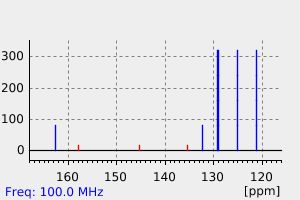N-(4-nitrophenyl)benzylideneamine | 1613-94-1
中文名称
——
中文别名
——
英文名称
N-(4-nitrophenyl)benzylideneamine
英文别名
(E)-N-benzylidene-4-nitroaniline;N-benzylidene-p-nitroaniline;benzylidene-p-nitroaniline;N-(E)-benzylidene-4-nitro-aniline;N-benzylidene-4-nitro-aniline
CAS
1613-94-1
化学式
C13H10N2O2
mdl
——
分子量
226.235
InChiKey
NYJOAZXGKLCRSV-GXDHUFHOSA-N
BEILSTEIN
——
EINECS
——
-
物化性质
-
计算性质
-
ADMET
-
安全信息
-
SDS
-
制备方法与用途
-
上下游信息
-
文献信息
-
表征谱图
-
同类化合物
-
相关功能分类
-
相关结构分类
计算性质
-
辛醇/水分配系数(LogP):3.35
-
重原子数:17.0
-
可旋转键数:3.0
-
环数:2.0
-
sp3杂化的碳原子比例:0.0
-
拓扑面积:55.5
-
氢给体数:0.0
-
氢受体数:3.0
SDS
上下游信息
反应信息
-
作为反应物:描述:N-(4-nitrophenyl)benzylideneamine 在 copper(l) iodide 、 silver tetrafluoroborate 盐酸 、 4 A molecular sieve 作用下, 以 丙酮 为溶剂, 反应 1.5h, 生成 ethyl trans-2-hydroxy-3-(p-nitrophenyl)amino-3-phenylpropanoate参考文献:名称:通过铜催化将丙酮和重氮乙酸乙酯加成到亚胺上来合成1,3-恶唑烷摘要:通过在丙酮存在下铜催化重氮乙酸乙酯向亚胺的高产率获得1,3-氧唑烷。用6N HCl水解恶唑烷,得到1,2-氨基醇。DOI:10.1016/s0040-4039(01)00479-8
-
作为产物:描述:参考文献:名称:Swellable organically modified silica as nanoreactors摘要:本公开提供了使用可膨胀有机改性二氧化硅(SOMS)作为纳米反应器进行化学反应和进行多步化学反应的方法。公开号:US11845055B2
-
作为试剂:描述:2,2,3,3-tetramethyl-1,1-dibromocyclopropane 在 N-(4-nitrophenyl)benzylideneamine 、 铁粉 、 zinc dibromide 作用下, 以 氯仿 为溶剂, 生成 3-bromo-2,4-dimethylpenta-1,3-diene参考文献:名称:锌/铁介导的二溴环丙烷开环与缺电子醛和亚胺的原位 Diels-Alder 反应摘要:二溴环丙烷可以通过使用催化量的二溴化锌和亚化学计量量的铁粉来开环。醛、酮、乙醛酸酯或亚胺的羰基的存在是开环反应所必需的。开环产生溴官能化的 1,3-二烯,然后在杂狄尔斯-阿尔德反应中与羰基原位反应。这些产品的形成对区域化学进行了高度控制,并且对于缺电子醛和亚胺(例如氨基甲酸酯)的收率很高。(E)-乙基2-(甲氧基羰基亚氨基)乙酸乙酯的应用导致了环状α-氨基酸衍生物。还报道了不对称二溴和二卤代环丙烷的使用。DOI:10.1002/ejoc.201300726
文献信息
-
Epoxides and Aziridines from Diazoacetates via Ylide Intermediates作者:Michael P. Doyle、Wenhao Hu、Daren J. TimmonsDOI:10.1021/ol015600x日期:2001.3.1An effective methodology is reported for stereospecific epoxidation and aziridination via carbonyl ylide intermediates using rhodium(II) acetate catalyzed reactions of phenyl- and styryldiazoacetates with aldehydes, ketones, or imines.
-
Catalytic Addition Methods for the Synthesis of Functionalized Diazoacetoacetates and Application to the Construction of Highly Substituted Cyclobutanones作者:Michael P. Doyle、Kousik Kundu、Albert E. RussellDOI:10.1021/ol052003s日期:2005.11.1[reaction: see text] Methyl 3-(trialkylsilanyloxy)-2-diazo-3-butenoate undergoes Lewis acid-catalyzed Mukaiyama aldol addition with aromatic and aliphatic aldehydes in the presence of low catalytic amounts of Lewis acids in nearly quantitative yields. Scandium(III) triflate is the preferred catalyst and, notably, addition proceeds without decomposition of the diazo moiety. Diazoacetoacetate products
-
DDQ-mediated formation of carboncarbon bonds: Oxidation of imines作者:Barbara Bortolotti、Rino Leardini、Daniele Nanni、Giuseppe ZanardiDOI:10.1016/s0040-4020(01)80210-6日期:1993.1The reaction of imines with alkynes and alkenes, in the presence of 2,3-dichloro-5,6-dicyano-p-benzoquinone (DDQ), to give quinoline derivatives is described. The mechanism of the annulation is discussed, and evidence supporting a non-concerted pathway, at least when the alkene is butyl vinyl ether, is reported. Preliminary information is also given about solid adducts of imines with DDQ, which do
-
Solvent-free synthesis of azomethines, spectral correlations and antimicrobial activities of some E-benzylidene-4-chlorobenzenamines作者:R. Suresh、S. P. Sakthinathan、D. Kamalakkannan、K. Ranganathan、K. Sathiyamoorthi、V. Mala、R. Arulkumaran、S. Vijayakumar、R. Sundararajan、G. Vanangamudi、M. Subramanian、G. Thirunarayanan、G. Vanaja、P. KanagambalDOI:10.4314/bcse.v29i2.10日期:——Some azomethines including substituted benzylidene-4-chlorobenzenamines (E-imines) have been synthesized by fly-ash: PTS catalyzed microwave assisted condensation of 4-chloroaniline and substituted benzaldehydes under solvent-free conditions. The yield of the imines has been found to be more than 85%. The purity of all imines has been checked using their physical constants and UV, IR and NMR spectral data. These spectral data have been correlated with Hammett substituent constants and F and R parameters using single and multi-linear regression analysis. From the results of statistical analysis, the effect of substituents on the above spectral data has been studied. The antimicrobial activities of all imines have been studied using standard methods.
-
Thiazolidin-4-one formation. Mechanistic and synthetic aspects of the reaction of imines and mercaptoacetic acid under microwave and conventional heating作者:Adele Bolognese、Gaetano Correale、Michele Manfra、Antonio Lavecchia、Ettore Novellino、Vincenzo BaroneDOI:10.1039/b405400h日期:——Microwave irradiation of a mixture of benzylidene-anilines and mercaptoacetic acid in benzene gives 1,3-thiazolidin-4-ones in very high yield (65–90%), whereas the same reaction performed through using the conventional method, at reflux temperature, requires a much longer time and gives a much lower yield (25–69%). This difference seems to be due to some intermediates and by-products formed during the conventional reaction. On the basis of 1H NMR studies, two different mechanisms, acting in benzene and in DMF, respectively, have been hypothesized for the thiazolidin-4-one system formation.
表征谱图
-
氢谱1HNMR
-
质谱MS
-
碳谱13CNMR
-
红外IR
-
拉曼Raman
-
峰位数据
-
峰位匹配
-
表征信息
同类化合物
(βS)-β-氨基-4-(4-羟基苯氧基)-3,5-二碘苯甲丙醇
(S,S)-邻甲苯基-DIPAMP
(S)-(-)-7'-〔4(S)-(苄基)恶唑-2-基]-7-二(3,5-二-叔丁基苯基)膦基-2,2',3,3'-四氢-1,1-螺二氢茚
(S)-盐酸沙丁胺醇
(S)-3-(叔丁基)-4-(2,6-二甲氧基苯基)-2,3-二氢苯并[d][1,3]氧磷杂环戊二烯
(S)-2,2'-双[双(3,5-三氟甲基苯基)膦基]-4,4',6,6'-四甲氧基联苯
(S)-1-[3,5-双(三氟甲基)苯基]-3-[1-(二甲基氨基)-3-甲基丁烷-2-基]硫脲
(R)富马酸托特罗定
(R)-(-)-盐酸尼古地平
(R)-(-)-4,12-双(二苯基膦基)[2.2]对环芳烷(1,5环辛二烯)铑(I)四氟硼酸盐
(R)-(+)-7-双(3,5-二叔丁基苯基)膦基7''-[((6-甲基吡啶-2-基甲基)氨基]-2,2'',3,3''-四氢-1,1''-螺双茚满
(R)-(+)-7-双(3,5-二叔丁基苯基)膦基7''-[(4-叔丁基吡啶-2-基甲基)氨基]-2,2'',3,3''-四氢-1,1''-螺双茚满
(R)-(+)-7-双(3,5-二叔丁基苯基)膦基7''-[(3-甲基吡啶-2-基甲基)氨基]-2,2'',3,3''-四氢-1,1''-螺双茚满
(R)-(+)-4,7-双(3,5-二-叔丁基苯基)膦基-7“-[(吡啶-2-基甲基)氨基]-2,2”,3,3'-四氢1,1'-螺二茚满
(R)-3-(叔丁基)-4-(2,6-二苯氧基苯基)-2,3-二氢苯并[d][1,3]氧杂磷杂环戊烯
(R)-2-[((二苯基膦基)甲基]吡咯烷
(R)-1-[3,5-双(三氟甲基)苯基]-3-[1-(二甲基氨基)-3-甲基丁烷-2-基]硫脲
(N-(4-甲氧基苯基)-N-甲基-3-(1-哌啶基)丙-2-烯酰胺)
(5-溴-2-羟基苯基)-4-氯苯甲酮
(5-溴-2-氯苯基)(4-羟基苯基)甲酮
(5-氧代-3-苯基-2,5-二氢-1,2,3,4-oxatriazol-3-鎓)
(4S,5R)-4-甲基-5-苯基-1,2,3-氧代噻唑烷-2,2-二氧化物-3-羧酸叔丁酯
(4S,4''S)-2,2''-亚环戊基双[4,5-二氢-4-(苯甲基)恶唑]
(4-溴苯基)-[2-氟-4-[6-[甲基(丙-2-烯基)氨基]己氧基]苯基]甲酮
(4-丁氧基苯甲基)三苯基溴化磷
(3aR,8aR)-(-)-4,4,8,8-四(3,5-二甲基苯基)四氢-2,2-二甲基-6-苯基-1,3-二氧戊环[4,5-e]二恶唑磷
(3aR,6aS)-5-氧代六氢环戊基[c]吡咯-2(1H)-羧酸酯
(2Z)-3-[[(4-氯苯基)氨基]-2-氰基丙烯酸乙酯
(2S,3S,5S)-5-(叔丁氧基甲酰氨基)-2-(N-5-噻唑基-甲氧羰基)氨基-1,6-二苯基-3-羟基己烷
(2S,2''S,3S,3''S)-3,3''-二叔丁基-4,4''-双(2,6-二甲氧基苯基)-2,2'',3,3''-四氢-2,2''-联苯并[d][1,3]氧杂磷杂戊环
(2S)-(-)-2-{[[[[3,5-双(氟代甲基)苯基]氨基]硫代甲基]氨基}-N-(二苯基甲基)-N,3,3-三甲基丁酰胺
(2S)-2-[[[[[((1S,2S)-2-氨基环己基]氨基]硫代甲基]氨基]-N-(二苯甲基)-N,3,3-三甲基丁酰胺
(2S)-2-[[[[[[((1R,2R)-2-氨基环己基]氨基]硫代甲基]氨基]-N-(二苯甲基)-N,3,3-三甲基丁酰胺
(2-硝基苯基)磷酸三酰胺
(2,6-二氯苯基)乙酰氯
(2,3-二甲氧基-5-甲基苯基)硼酸
(1S,2S,3S,5S)-5-叠氮基-3-(苯基甲氧基)-2-[(苯基甲氧基)甲基]环戊醇
(1S,2S,3R,5R)-2-(苄氧基)甲基-6-氧杂双环[3.1.0]己-3-醇
(1-(4-氟苯基)环丙基)甲胺盐酸盐
(1-(3-溴苯基)环丁基)甲胺盐酸盐
(1-(2-氯苯基)环丁基)甲胺盐酸盐
(1-(2-氟苯基)环丙基)甲胺盐酸盐
(1-(2,6-二氟苯基)环丙基)甲胺盐酸盐
(-)-去甲基西布曲明
龙蒿油
龙胆酸钠
龙胆酸叔丁酯
龙胆酸
龙胆紫-d6
龙胆紫







